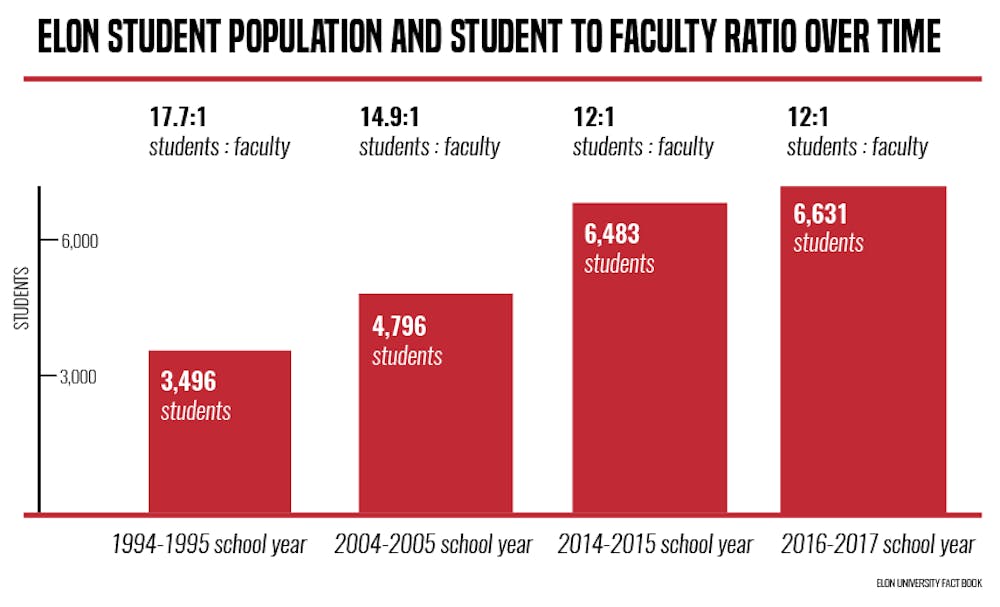Correction: The graphic initially posted listed incorrect student to faculty ratios for the 1994-1995, 2004-2005 and 2014-2015 school years. The graphic has been updated to reflect the correct ratios for those years. Elon News Network regrets the error.
Elon University prides itself on maintaining small class sizes across its disciplines, boasting a 12-to-1 student-faculty ratio and an average class size of 20 students, according to the Elon website. But with a growing student body with numbers increasing each year, Elon is now considered a medium-sized school — no longer small-sized — and the question is raised on what Elon is doing to maintain its student/faculty ratio and small classes.
Other mid-sized schools report similar numbers. According to the U.S. News and World Report, 74.6 percent of classes at Yale University have fewer than 20 students and an overall student-faculty ratio of 6 to 1; 73 percent of classes at Duke University have fewer than 20 students and a ratio of 7:1; and 70.2 percent of classes at Stanford University have fewer than 20 students with a 4:1 ratio.
Elon's vision for its own growth is slow, but steady.
"Elon is fully committed to maintaining the strength of community we all appreciate about the campus," said Vice President of Admissions and Financial Planning Greg Zaiser in an email. "As we slowly grow enrollment, we plan for facilities to accommodate this growth. The university is very forward-thinking and is presently considering the campus of 2030 and beyond.
"Maintaining our outstanding faculty/student ratio is a priority. As we plan for enrollment numbers, we budget for faculty lines to maintain the ratio and keep class sizes small. These are two hallmarks of an Elon education so you can be confident in knowing these are priorities."
Professors that have been at Elon for a while have also benchmarked Elon's growth in their class sizes.
"When I started here in the late 70s and early 80s, classes were larger for me than they are now," said Assistant Professor of Journalism and Communications Gerald Gibson, who is starting his 35th year of teaching at Elon. "You would have 25 or more people in a class. Classes were larger because we had fewer faculty and didn't have as much of a physical footprint as we have now. We have more classrooms and more faculty."
When the School of Communications moved into McEwen, its current building, there were 11 full-time faculty members — but that number has increased to around 60, including adjunct and visiting professors, according to Gibson. He attributes smaller class sizes to the increase of resources and faculty, along with certain accreditation standards mandating Elon keep class sizes a certain number.
"That's a commitment the university has made, in terms of hiring people to bring those numbers down and to have world-class facilities to teach in," he said.
As the school continues to expand its reach, with new residential living areas — such as Global Neighborhood and Park Place — and new academic amenities — such as the expansions of both the business and communications schools — Elon's administration will strive to maintain its close campus feel and continue to preserve its small class sizes and student/faculty ratio.
Gibson said that, with increasing student numbers, there is a concern that Elon would lose its sense of a being a tight community, but "it's a conscious effort to try and keep it."
Zaiser agreed, saying that what draws faculty and staff to Elon is the opportunity to work so closely with undergraduate students — and that close relationship wouldn't be possible without the commitment to keeping the faculty/student ratio small.
"Students are always the focus of everything we do at Elon, and knowing the strong sense of community is something we all enjoy about campus (and is attractive to prospective students) there is a natural desire to work toward the strong relationships that are fundamental to what Elon is all about," he said.


